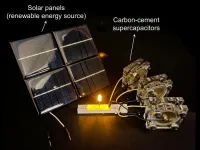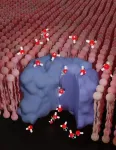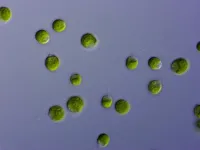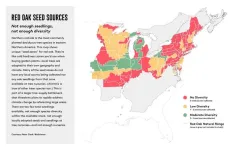(Press-News.org) RICHLAND, Wash. – A novel method to extract lignin could help spin wheat straw into gold. Lignin produced using the new method was color-neutral, odorless and homogenous, an advance that could make this carbon-neutral material a more viable candidate for development of high-value products.
Reporting in the Proceedings of the National Academy of Sciences, the Washington State University researchers extracted up to 93% lignin with up to 98% purity from wheat straw, producing a significant amount of material in a uniform way that could make it more attractive for industry use.
“This method allows us to extract lignin from plant material in its native form and at a high yield,” said Xiao Zhang, professor in WSU’s Gene and Linda Voiland School of Chemical Engineering and Bioengineering, who led the work. “We were able to demonstrate to industry that it is possible to make color-neutral and odorless lignin, and we can make quite a bit of the material to begin evaluating its applications.”
Lignin is the second most abundant renewable carbon source, making up about 30% of the non-fossil fuel-based carbon on Earth. It is in all vascular plants, where it forms cell walls and provides plants with rigidity. Lignin allows trees to stand, gives vegetables their firmness and makes up about 20%-35% of the weight of wood. The material holds great promise as a precursor for biobased materials and fuels, but it is also notoriously difficult to extract from plants.
The material is usually separated during papermaking and biorefining, but these processes often contaminate and significantly alter lignin’s chemical and physical properties, decreasing its value. So most lignin is either burned to produce fuel and electricity or used in low-value products, such as for cement additives or as a binder in animal feed. Producing a more homogenous lignin provides the opportunity to pursue high-value material development to replace petroleum-derived plastics and polymers.
“Because of its heterogeneity, lignin can’t be used as a valuable material despite centuries of effort,” said Zhang, who holds a joint appointment with Pacific Northwest National Laboratory. “The saying has been that ‘you can make anything out of lignin, except money.’ There’s so much heterogeneity in the molecules that nobody can reliably make things out of it.”
In their work, the researchers used a solvent to separate the lignin from wheat straw and were able to preserve and control its key properties, producing a more uniform molecule with a consistent molecular weight that makes it more useful for industry. The lignin extracted was light-colored, which is more like the lignin that exists in nature.
Because it is an electron-rich compound, the lignin had a strong affinity for the solvent, and the electron interactions allowed the researchers to extract it with minimal chemical reactions, which protected its natural molecular structure that is so often easily damaged in chemical separations.
WSU’s Office of Commercialization has filed a provisional patent and will assist the researchers for the scale-up and eventual commercialization of this technology. To make it more viable for industry applications, the research team is working to decrease the lengthy processing time and the amount of purification chemicals needed.
The work was done in collaboration with Edoardo Apra, a computational scientist from PNNL, and Professor Art Ragauskas from University of Tennessee, Knoxville. It was supported by the National Science Foundation and the U.S. Department of Agriculture National Institute of Food and Agriculture as well as WSU’s Commercialization Gap fund.
END
Lignin separation method could make renewable material profitable
2023-07-31
ELSE PRESS RELEASES FROM THIS DATE:
Hydrogen sulfide shows promise as healthy ageing therapeutic when specifically targeted within cells
2023-07-31
Future therapies to help people live healthy lives for longer could be developed from drugs that release tiny amounts of the gas hydrogen sulfide (H2S), new research has indicated.
A study from the University of Exeter, funded by the US Army and charity The United Mitochondrial Disease Foundation, found that targeting tiny amounts of H2S to specific areas of cells in adult worms using a H2S-releasing molecule called AP39, greatly improved health and activity as they aged. The research, published in PNAS, concludes that targeting ...
MIT engineers create an energy-storing supercapacitor from ancient materials
2023-07-31
CAMBRIDGE, Mass. -- Two of humanity's most ubiquitous historical materials, cement and carbon black (which resembles very fine charcoal), may form the basis for a novel, low-cost energy storage system, according to a new study. The technology could facilitate the use of renewable energy sources such as solar, wind, and tidal power by allowing energy networks to remain stable despite fluctuations in renewable energy supply.
The two materials, the researchers found, can be combined with water to make a supercapacitor — an alternative to batteries — ...
How flies develop sight: Scientists use single-cell sequencing to identify cell types in the visual system
2023-07-31
New York University researchers have discovered new cell types in the visual system of flies, made possible by their creation of a tool that finds and labels neurons during development.
The study, published in the journal Proceedings of the National Academy of Sciences (PNAS), combines single-cell sequencing data with a novel algorithm to identify pairs of genes that point to previously unknown cells in the brains of fruit flies.
Fruit flies (also known as Drosophila) have long been used as a model organism to study fundamental ...
Study reveals long-debated makeup of the molecules that help organize your cells
2023-07-31
For years, we’ve known that a special kind of molecular assembly known as a “polyelectrolyte complex” helps your cells keep themselves organized. These complexes are very good at forming interfaces to keep two liquids separated: your cells use them to create compartments. These abilities have led scientists to consider them for technological applications, including filtering water, better batteries, and even underwater glue, as well as for better pharmaceutical drugs.
But for decades, no one knew exactly ...
How to distinguish slow and fast earthquakes
2023-07-31
Researchers from the University of Tokyo and Stanford University show what differentiates slow and fast earthquakes and how their magnitudes vary with time.
Normally, earthquakes last up to a few minutes and radiate strong seismic waves. But around 23 years ago, scientists discovered an unusual slow-slip phenomena called slow earthquakes. Slow earthquakes last days or even months. Though they involve significant tectonic movement, you may never feel them. Since slow earthquakes could indicate future fast earthquakes, monitoring and ...
Research shows filter tip stent retrievers may allow neurointerventionalists to remove blood clots on the first try during stroke treatment
2023-07-31
FOR IMMEDIATE RELEASE: July 31, 2023, 12:00 P.M. PDT
CONTACT: Camille Jewell
cjewell@vancomm.com or 202-248-5460
Research Shows Filter Tip Stent Retrievers May Allow Neurointerventionalists to Remove Blood Clots on the First Try During Stroke Treatment
SAN DIEGO—Research presented today at the Society of NeuroInterventional Surgery’s (SNIS) 20th Annual Meeting shows that different types of stent retriever tips may result in improved patient outcomes when performing mechanical thrombectomy to treat stroke.
Ischemic stroke, one of the most common types of strokes, happens ...
Nuclear spin's impact on biological processes uncovered
2023-07-31
A research team led by Prof. Yossi Paltiel at the Hebrew University of Jerusalem with groups from HUJI, Weizmann and IST Austria new study reveals the influence of nuclear spin on biological processes. This discovery challenges long-held assumptions and opens up exciting possibilities for advancements in biotechnology and quantum biology.
Scientists have long believed that nuclear spin had no impact on biological processes. However, recent research has shown that certain isotopes behave differently due to their nuclear spin. The team focused on stable oxygen isotopes (16O, 17O, 18O) and found ...
Researchers use geospatial mapping to assist burn patients
2023-07-31
University of Texas at Dallas researchers are using geospatial mapping techniques to identify social and environmental obstacles in communities that might impede burn injury survivors’ reentry into society.
The project is designed to help patients with burn injuries better adapt to their lives after medical discharge, including improving patient access to transportation, employment, food and other necessities.
“Our study looks at how people who survive burn injuries reenter the community,” said Dr. Richard Scotch, program head of sociology and a professor of public policy and political economy in the School of ...
Diving deep: Unveiling the secrets of microalgae to cope with environmental challenges.
2023-07-31
Environmental change, such as ocean warming, alters resource competition and biodiversity. Thus, it is essential to understand how organisms respond to increased competition because changes in their size and metabolism affect the productivity of ecosystems.
Competition has long been recognized as a driving force behind rapid evolution. Still, until now, a mechanistic framework for identifying the specific traits that evolve and their trajectories has yet to be developed. Researchers at Gulbenkian and Monash University turned to metabolic theory, which explicitly predicts how competition shapes the evolution of metabolism ...
Plans to plant billions of trees threatened by massive undersupply of seedlings
2023-07-31
The REPLANT Act provides money for the US Forest Service to plant more than a billion trees in the next nine years. The World Economic Forum aims to help plant a trillion trees around the world by 2030. Many US cities have plans to shade their streets with millions of trees. Major government and private funding is being invested in planting trees as a powerful tool to fight climate change, protect water, clean air, and cool cities. In short, trees are hot.
But new research shows a troubling bottleneck that could threaten these efforts: U.S. ...





